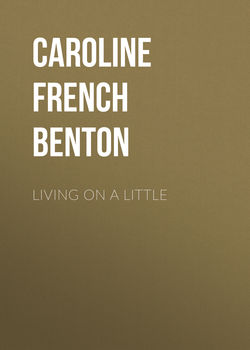Читать книгу Living on a Little - Caroline French Benton, Caroline French Benton - Страница 4
CHAPTER IV
Soups and Meats
Оглавление"When I came to look over what you said about soups and meats the other day," Dolly complained at the next lesson, "I found it was all glittering generalities. I didn't have a thing written down under soups but 'beans' and 'split peas,' and as to meats, it was mostly don'ts or left-overs. Now, before you go off on anything else, suppose you tell me a lot more about these things."
"So I will. Perhaps I did generalize a bit, but I do not always realize that you do not know how to use a cook-book yet; if you did you could look up all these things for yourself.
"To begin with soups, then, like 'all Gaul,' they are divided into three parts.' There are soups made with vegetables and water and nothing else; soups made with a foundation of meat and bones; and milk-and-vegetable soups. The first kind is the cheapest, and we will start there.
"There are any number of good things to make these soups of, principally beans, – black, white, red, and Lima beans, all dried. You must soak them, cook them slowly in another water, season well with a slice of onion, salt, and pepper, and put them, when they are soft and pulpy, through the sieve. What is called a purée sieve is the best, because it is made in such a way that it presses the vegetables through itself. Then you must thicken the soup with a little bit of butter melted and rubbed with flour; this is not because it is not thickened with the vegetables already, but because the water will separate from the rest if no extra thickening is used. You can have the soup rather thin to make it just right after it is thickened.
"Black bean soup is the best kind; this really needs a bone of some sort cooked with it, a ham bone if you have it. Then it takes lots of seasoning, a pinch of mustard, a thin slice or two of lemon, and last a little chopped hard-boiled egg on top at serving; but it pays for the slight trouble of making it because it is so good; have it often in winter. White bean soups also need a good deal of seasoning, and a bone is good in them, but not really necessary. Left-over baked beans make a good brown soup, and dried Lima beans are excellent; alternate these, and make each one by rule, for each has some little touch of seasoning which makes it have a taste of its own. Any cook-book will tell you how, because all of them are so simple to put together. Besides these there is one more thick soup, split pea purée, which you must have too. You can buy the peas in packages, but you can also get them in bulk, and that is the cheaper way. You soak and cook them exactly as you do the beans, and serve them with croutons on top; croutons are tiny squares of bread browned in the oven, – not fried in fat, as some people make them; those are very greasy.
"You can also make purées of any fresh vegetable, carrots, or garden peas, or a mixture of several kinds of vegetables; cook them with onion and salt and pepper and bits of celery or parsley, and put them through the sieve and thicken them. All of them are improved by adding a little milk, but they will do as they are if you have none to spare."
"Do you put a bone in purées?"
"If I happen to have one I do, but not otherwise; I never buy a bone for such a soup. Remember that these thick soups go with the dinners with the light meat course, because they are so substantial. Now we will go on to the next kind.
"The stock soups are made with water, bones, meat, and vegetables. Some housekeepers keep a stock pot on the back of the range and put in it any odds and ends they happen to have, adding more water and seasoning from time to time. When they want a soup, they pour off enough of the stock, strain and clarify it, and either use it as it is or put in something like tomato or potato. This is all very well if you have a range which goes day and night, and if you are careful to completely empty the pot twice a week in winter and three times a week in summer and scrub it out thoroughly and start an entirely fresh lot of bones and meat; otherwise the whole will have a sour taste. I think a better way is to start a soup on the fire and cook it all night in the tireless stove; start it over again in the morning, and cook it half a day more, and then cool and use it."
